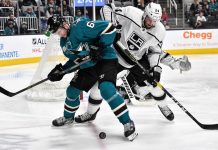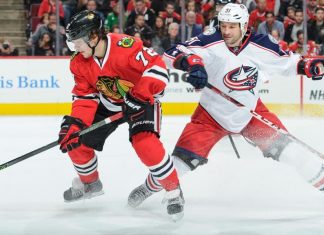NEW YORK (AP) There’s a P-word on players’ and coaches lips this playoffs, and it has nothing to do with getting pucks in deep.
”Parity in the league, it’s insanely tight,” Colorado coach Jared Bednar said.
This has been the postseason of parity with all four division champions gone and the potential that the seventh- and eighth-seeded teams on each side meet in the conference finals. This is the world Commissioner Gary Bettman envisioned when the NHL instituted a salary cap in 2005 after a yearlong lockout.
Bettman prefers to call it ”competitive balance,” and it’s the thing he trumpets the most about the state of the league where almost anyone can contend for the Stanley Cup in a given season.
If there’s ever a time to showcase competitive balance, it’s now, with Carolina already into the East final, Dallas on the verge of reaching the West final and top-shelf hockey almost every night, even if many big markets are gone.
”Everything starts with the game, what takes place on the ice,” Bettman told The Associated Press on Tuesday. ”You can’t market and promote around a product that is inferior.
”When the game is good, authentic, entertaining, then you can market it and promote it and reach out to new people. Frankly it comes down to story lines, to player performance and that is as important, if not more so, than what cities are being represented.”
There’s not a lot of national buzz if teams from Raleigh, North Carolina, and Columbus, Ohio, meet in the third round of the playoffs. But when the Cinderella Hurricanes face the Blue Jackets or Boston Bruins, it should be a continuation of one of the wackiest, wildest postseasons in recent history.
Carolina in the conference final would’ve been difficult to imagine in the late 1990s when big-market teams spent like crazy and could tilt the ice against those from smaller markets. It’s referred to now as the ”Dead Puck Era” because scoring was repressed, and Bettman remembers the conversations he’d have with coaches of some of those lower-revenue clubs back then.
”I said, `What’s your strategy going into a game?’ And they would say, `We clutch, we grab, we hook and hold – we neutralize skill for 50 minutes and then we try and steal the game,”’ Bettman recalled.
”And that’s why the game looked the way it did, and many people weren’t happy with it and many teams knew at the start of the season, (and) fans knew, they couldn’t compete.”
The hard salary cap that started at $39 million and has reached $79.5 million still has its flaws, particularly the consequence of squeezing out the middle class of players with a bigger portion going to highly paid stars and more reliance on youth because of fixed entry-level contracts.
From a collective bargaining standpoint, it has also created problems for players paying varying escrow rates to even out the revenue split with owners, and that’s an issue that will fill up plenty of time in meeting rooms in the coming months.
Inside arenas this spring is the positive side of parity. The Hurricanes ended the league’s longest playoff drought after a decade, the Blue Jackets won their first series in franchise history and the Avalanche and Stars are able to go punch-for-punch with the best in the West.
”It’s just a testament to how close our clubs are competitively,” Deputy Commissioner Bill Daly said. ”I don’t think that’s a problem with the system. I think that’s a unique aspect to the system. I think it’s worked well. I don’t think you’ll see it every year. But you won’t be surprised when it happens again.”
It’s no longer surprising when teams make the playoffs after being out of the picture around Thanksgiving or when there’s a significant turnover from year to year. Four of the 16 playoff teams didn’t make it last year, and of the eight to reach the second round, only the Bruins and Sharks got that far last season.
Absent a potential Boston-San Jose Cup Final that would showcase a tradition-filled Original Six organization with one that made the Bay Area into a modern hockey market, there are some combinations that don’t exactly sizzle for those who aren’t avid fans.
The league had a run of Tampa Bay-Calgary, Carolina-Edmonton and Ottawa-Anaheim finals in the first three seasons of the salary-cap era, a stretch of three Chicago Blackhawks titles in six years and only one back-to-back champion in Pittsburgh in 2016 and 2017.
Bettman said nothing in sports is better than the first round of the NHL’s playoffs, and NBC Sports reported the highest first-round ratings in the network’s history. If more big markets go out, that picture could change and interest could wane, but Bettman believes it all evens out over time.
”Will ratings vary from year to year? Yes. And that is one of the results of this type of system. Some would say one of the consequences,” Bettman said.
”Obviously if you take two big-market teams and they’re in the Stanley Cup Final, your ratings are likelier to be higher than if you have two small markets. And over time that can change, and the NFL’s a good example of that. The Super Bowl it doesn’t matter who’s playing.”
Parity is of course more fun for those caring about teams that didn’t have dominant regular seasons only to lose early – sorry, Tampa Bay – but the league this way is able to engage more fan bases. A couple of years ago it was Nashville and the outdoor parties on Broadway, last season it was Washington and this time it’s Columbus and Carolina and even San Jose.
Bettman pointed out this is the first time in the NHL’s 102-year history that every playoff game is on national television in the U.S., with the lack of that in past decades a cause of some of the sport’s regionalization. He hopes that can change over the next 20 years as fans of all kinds of teams experience the rush of playoff hockey.
”Once you make the playoffs, anything can happen,” he said. ”And it does.”
—
AP Sports Writers Tim Booth and Pat Graham contributed.
—
Follow AP Hockey Writer Stephen Whyno on Twitter at https://twitter.com/SWhyno
—
More AP NHL: https://apnews.com/NHL and https://twitter.com/AP-Sports
25% Bonus via Western Union























